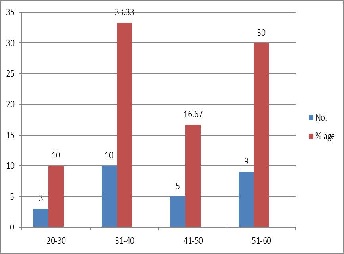Functional outcome of minimally invasive plate osteosynthesis (MIPO) in proximal tibial fractures
Abstract
Introduction: This study is undertaken to evaluate the outcome of the MIPO technique in Proximal Tibial Condyle Fractures which is expected to provide a stable fixation with minimum exposure, early mobilization, fewer complications, and a better quality of life.
Material and methods: Study design: Prospective cohort study carried out at C.U Shah Medical College. 30 cases of proximal tibia fractures (Schatzker type 1- VI) operated with the MIPO technique. Follow-up of these patients was done at 6 months and 9 months after surgery by using Sanders's 40-point functional scale.
Results: There were 16 cases of Schatzker type I fractures, 5 cases of Type II, 4 cases of type III, 2 cases of type IV, 1 case of type V and 2 cases of type VI fractures. The healing process was determined by radiographically and functionally. Meantime to union was 17.6 weeks, with 50 % of fractures uniting in 14-16 weeks. Infection was observed in two cases (10%), two cases of collapse of fracture, and two cases of malunion. Sanders's score was applied to analyze the functional outcome among the cases. 63% of patients had excellent performance, 20% had good results, 13% had fair results and one patient performed poorly.
Conclusion: MIPO is a good technique to stabilize the proximal tibia condyle fractures especially when used with meticulous intraoperative handling of soft tissues.
Downloads
References
Agnew SG. Tibial Plateau Fractures. Operative Tech Orthop, 1999;9(3):197-205. doi: https://doi.org/10.1016/S1048-6666(99)80018-4.
Gaston P, Will EM, Keating JF. Recovery of knee function following fracture of the tibial plateau. J Bone Joint Surg Br. 2005;87(9):1233-1236. doi: https://doi.org/10.1302/0301-620x.87b9.16276.
Egol KA, Su E, Tejwani NC, Sims SH, Kummer FJ, Koval KJ. Treatment of complex tibial plateau fractures using the less invasive stabilization system plate: clinical experience and a laboratory comparison with double plating. J Trauma. 2004;57(2):340-346. doi: https://doi.org/10.1097/01.ta.0000112326.09272.13.
Smith WR, Ziran BH, Anglen JO, Stahe PF. Locking Plates: Tips and Tricks. J Bone Joint Surg Am. 2007;89(10):2298-2307. doi: https://doi.org/10.2106/00004623-200710000-00028.
Hak DJ, Lee M, Gotham DR. Influence of Prior Fasciotomy on Infection After Open Reduction and Internal Fixation of Tibial Plateau Fractures. J Trauma. 2010;69(4):886-888. doi: https://doi.org/10.1097/ta.0b013e3181b83fe9.
Zura RD, Adams SB, Jeray KJ, Obremskey WT, Stinnett SS, Olson SA. Timing of definitive fixation of severe tibial plateau fractures with compartment syndrome does not have an effect on the rate of infection. J Trauma. 2010;69(6):1523-1526. doi: https://doi.org/10.1097/ta.0b013e3181d40403.
Marti RK, Kerkhoffs GM, Rademakers MV. Correction of lateral tibial plateau depression and valgus malunion of the proximal tibia. Oper Orthop Traumatol. 2007;19(1):101-113. doi: https://doi.org/10.1007/s00064-007-1197-3.
Mathur H, Acharya S, Nijhawan VK, Mandal SP. Operative results of closed tibial plateau fractures. Indian J Orthop. 2005;39(2):108-112.
Jiang R, Luo CF, Wang MC, Yang TY, Zeng BF. A comparative study of Less Invasive Stabilization System (LISS) fixation and two-incision double plating for the treatment of bicondylar tibial plateau fractures. Knee. 2008;15(2):139-143. doi: https://doi.org/10.1016/j.knee.2007.12.001.
Phisitkul P, McKinley TO, Nepola JV, Marsh JL. Complications of locking plate fixation in complex proximal tibial injuries, J Orthop Trauma. 2007;21(2):83-91. doi: https://doi.org/10.1097/bot.0b013e318030df96.
Prasad GT, Kumar TS, Kumar RK, Murthy GK, Sundaram N. Functional outcome of Schatzker type V and VI tibial plateau fractures treated with dual plates. Indian J Orthop. 2013;47(2):188-194. doi: https://doi.org/10.4103/0019-5413.108915.
Oh CW, Oh JK, Kyung HS, Jeon IH, Park BC, Min WK, et al. Double plating of unstable proximal tibial fractures using minimally invasive percutaneous osteosynthesis technique, Acta Orthop. 2006;77(3):524-530. doi: https://doi.org/10.1080/17453670610012548.
Haidukewych G, Sems SA, Huebner D, Horwitz D, Levy B. Results of Polyaxial Locked-Plate Fixation of Periarticular Fractures of the Knee. J Bone Joint Surg Am. 2008;90:2(Part 1):117-134. doi: https://doi.org/10.2106/jbjs.g.01086.
Lee JA, Stamatios A. Papadakis, Moon C, Zalavras CG. Tibial plateau fractures treated with the less invasive stabilisation system. Int Orthop. 2007;31(3):415-418. doi: https://doi.org/10.1007/s00264-006-0176-x.
Schutz M, Kaab MJ, Haas N. Stabilization of proximal tibial fractures with the LIS-System: Early clinical experience in Berlin. Injury. 2003;34(1):A30-A35. doi: https://doi.org/10.1016/s0020-1383(03)00255-9.

Copyright (c) 2020 Author (s). Published by Siddharth Health Research and Social Welfare Society

This work is licensed under a Creative Commons Attribution 4.0 International License.


 OAI - Open Archives Initiative
OAI - Open Archives Initiative


















 Therapoid
Therapoid

